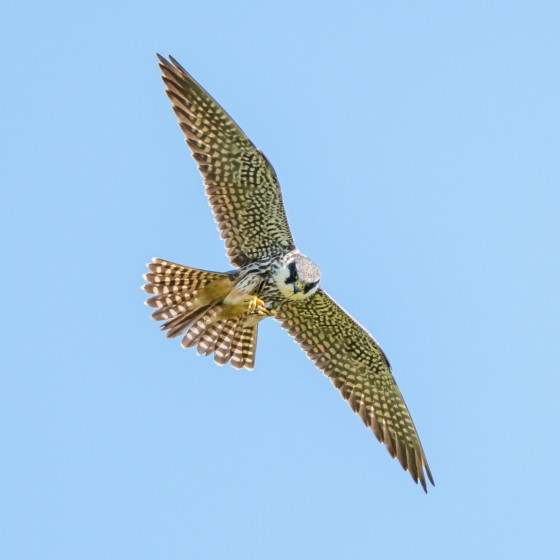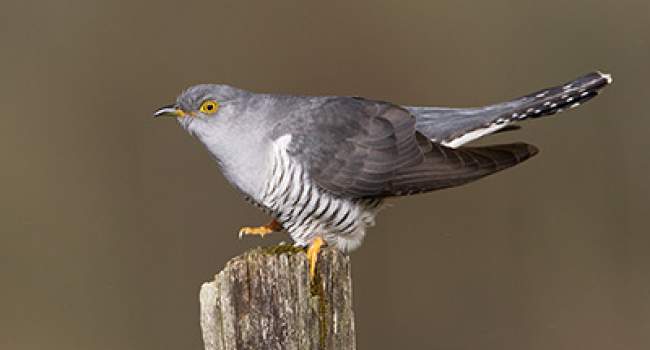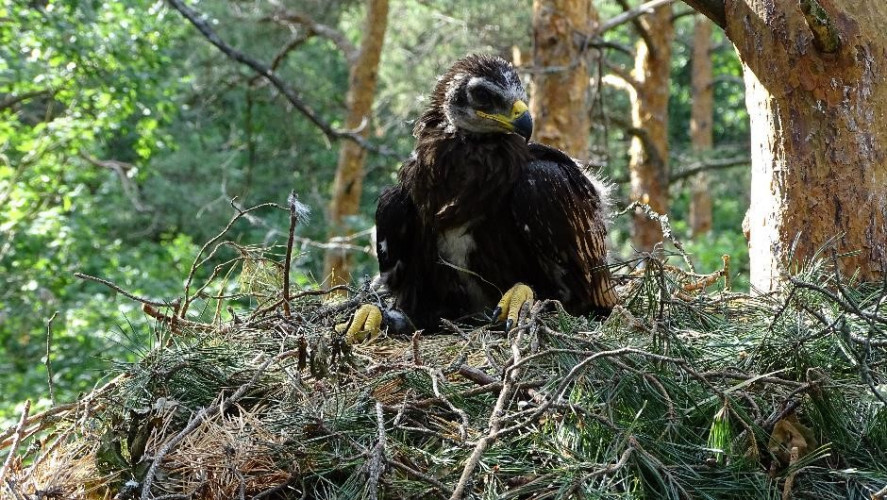Hobby
Falco subbuteo (Linnaeus, 1758)
HY
 HOBBY
HOBBY  3100
3100

Family: Falconiformes > Falconidae

The Hobby is always an exciting bird to see in flight, with its scythe-like wings, deftly hunting dragonflies or hirundines over wetland sites and lowland farmland.
Relatively scarce and secretive when breeding, the Hobby is a difficult bird to census. A few thousand pairs are thought to breed here, with the population restricted to the southern half of Britain and exhibiting greatest abundance in the south-east.
Arriving from Africa in April this Kestrel-sized but longer-winged falcon prefers open countryside, where it chases birds and insects with aerobatic mastery, often eating small prey on the wing.
Exploring the trends for Hobby
Our Trends Explorer will also give you the latest insight into how the UK's Hobby population is changing.
trends explorerIdentification
Hobby identification is often straightforward. The following article may help when identifying Hobby.
Identifying Cuckoo

Cuckoos are well-known birds, but their distinctive and eagerly awaited song can be confused with several other species. Despite their popularity, Cuckoos are rarely seen and, when they are, can easily be mistaken for a bird of prey. Let us help you pick out this iconic bird that was once believed to turn into a Sparrowhawk in the winter - neatly explaining it's silence and disappearance outside the breeding season.
- 1 of 2
- next ›
SONGS AND CALLS
Listen to example recordings of the main vocalisations of Hobby, provided by xeno-canto contributors.
Begging call
Call
Develop your bird ID skills with our training courses
Our interactive online courses are a great way to develop your bird identification skills, whether you're new to the hobby or a competent birder looking to hone your abilities.
Browse training coursesStatus and Trends
Population size and trends and patterns of distribution based on BTO surveys and atlases with data collected by BTO volunteers.
CONSERVATION STATUS
This species can be found on the following statutory and conservation listings and schedules.
POPULATION CHANGE
This species used to be too rare and unobtrusive for wide-scale monitoring but, following population increase, BBS is now able to produce a trend. Many BBS sightings, however, are likely to refer to migrants, first-summer non-breeders, or to breeding birds from distant nests. To establish whether nesting occurs in a locality, dedicated observers and specialised field methods are required, as described by Hardey et al. (2009). The Rare Breeding Birds Panel collects annual data on nesting pairs, which under-represent the true population to an unknown degree, but adequately establish the long-term upward trend (eg Holling & RBBP 2014). RBBP guidelines for recording this species are here. Numbers in parts of southeast England could be considerably higher than previously recognised (Clements & Everett 2012). Clements et al. (2016) looked at breeding densities from recent survey work in several areas, and concluded that the lower limit to the UK population estimate was 3,000 to 3,500 pairs, with perhaps as many as 5,000 pairs breeding. However, this is a tentative estimate, which needs to be confirmed with a full survey.
The Hobby's distribution has spread markedly northwards in England since the 1970s (Gibbons et al. 1993). The species is now widespread north to Lancashire and Co Durham (Balmer et al. 2013).
| UK breeding population |
No population change in UK (1995–2022) 
|
Exploring the trends for Hobby
Our Trends Explorer will also give you the latest insight into how the UK's Hobby population is changing.
trends explorerDISTRIBUTION
Hobbies are widespread in south and central Britain, with the exception of west Wales and Cornwall where they remain scarce. Further north they are thinly distributed as far north as south Northumberland. A small number breed in the Scottish Highlands but sporadic nesting pairs elsewhere in Scotland may have been overlooked.
Occupied 10-km squares in UK
| No. occupied in breeding season | 1033 |
| % occupied in breeding season | 34 |
| No. occupied in winter | 12 |
| % occupied in winter | 0.4 |
European Distribution Map
DISTRIBUTION CHANGE
Hobbies have undergone a large range expansion, now occupying four times as many 10-km squares as in the 1968–72 Breeding Atlas.
| % change in range in breeding season (1968–72 to 2008–11) | +295% |
SEASONALITY
Hobby is a summer visitor, mostly arriving from late April, with last birds departing in October and sometimes November.

Movement
Information about movement and migration based on online bird portals (e.g. BirdTrack), Ringing schemes and tracking studies.
An overview of year-round movements for the whole of Europe can be seen on the EuroBirdPortal viewer.
RINGING RECOVERIES
View a summary of recoveries in the Online Ringing Report.
Foreign locations of birds ringed or recovered in Britain & Ireland

Biology
Lifecycle and body size information about Hobby, including statistics on nesting, eggs and lifespan based on BTO ringing and nest recording data.
PRODUCTIVITY & NESTING
Exploring the trends for Hobby
Our Trends Explorer will also give you the latest insight into how the UK's Hobby population is changing.
trends explorerSURVIVAL & LONGEVITY
View number ringed each year in the Online Ringing Report
Maximum Age from Ringing 
|
14 years 10 months 19 days (set in 2007) 
|
Typical Lifespan 
|
5 years with breeding typically at 2 year |
Adult Survival 
|
0.745  
|
Juvenile Survival 
|
0.47 (in first year) 
|
Exploring the trends for Hobby
Our Trends Explorer will also give you the latest insight into how the UK's Hobby population is changing.
trends explorerCODES & CLASSIFICATION
Ring size 
|
E |
Field Codes 
|
2-letter: HY | 5-letter code: HOBBY | Euring: 3100 |
For information in another language (where available) click on a linked name
Research
Interpretation and scientific publications about Hobby from BTO scientists.
CAUSES AND SOLUTIONS
Causes of change
The causes of change are unclear, although changes in prey availability and a decreasing dependency on its traditional heathland habitat have been suggested as speculative reasons for the increases.
Further information on causes of change
The increases and northward range expansion since the 1970s are perhaps linked to increases in its dragonfly prey supplies (Prince & Clarke 1993) and to a decreasing dependency on its traditional heathland habitat, but the reasons underlying the increase are still only speculative (Clements 2001).
A success rate of more than 90% was recorded for nests in Derbyshire during 1992-2001, with successful nests fledging a mean of 2.44 young (Messenger & Roome 2007). The small annual samples of nest record cards indicate no long-term change in nest success.
Information about conservation actions
The trend for Hobby in the UK is stable or increasing, hence no specific conservation actions are currently required for this species. The causes of change are unclear and no conservation recommendations related to this species have been proposed.
PUBLICATIONS (2)

<p>Long-term Effects of Rewilding on Species Composition: 22-years of Raptor Monitoring in the Chernobyl Exclusion Zone </p>
Rewilding the Chernobyl Exclusion Zone

Long-term effects of rewilding on species composition: 22 years of raptor monitoring in the Chernobyl Exclusion Zone
Over 2,000 km² of Belarus previously given over to intensive agriculture and dense settlements was affected by the 1986 reactor meltdown at the Chernobyl Nuclear Plant in Ukraine.
Links to more studies from ConservationEvidence.com
Would you like to search for another species?











Share this page